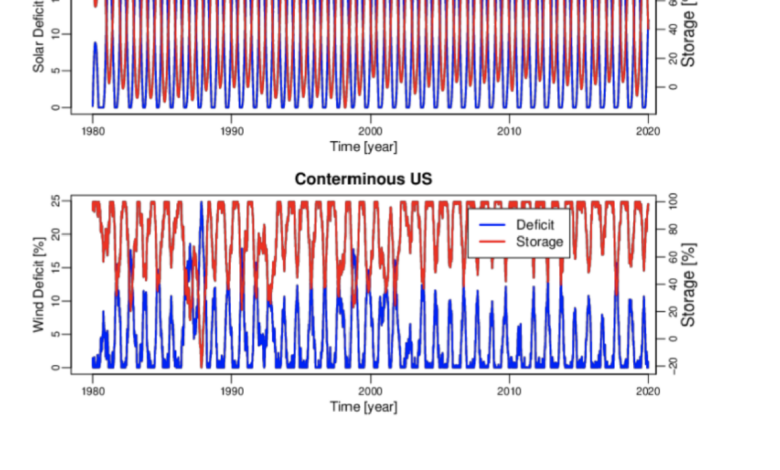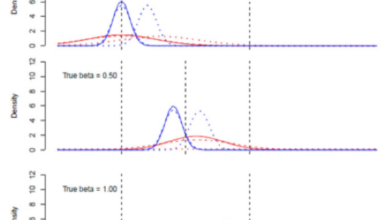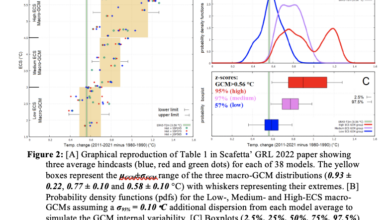Net-Zero Targets: Sustainable Future or CO2 Obsession Driven Dead-end?

by Balázs M. Fekete
For over three decades, the reduction of CO2 emission was the primary motivation for promoting the transition from fossil fuels to alternative energy sources. Concerns about the inevitable exhaustion of fossil fuels were considered particularly during energy crises, but these concerns died out quickly as discoveries of new fossil fuel reserves such as the shale revolution in the US that appeared to secure energy supplies.
An under-appreciated paper by Murphy et al. (1) offers very strong arguments that the energy transition is a must that has to happen in a short time. Anyone looking at Figure 1 from this paper should be more concerned about running out of fossil fuels than climate change. It is almost certain that the spike on Figure 1 will only last for a few centuries irrespective of the exact location of the star, and fossil fuel era will be only a fraction of the history of human civilizations. This period will not last long enough to deserve the proposed anthropocene[1] designation. The industrial era might rightfully be called a geological event that triggers post-anthropocene, but by no means will it last long enough to qualify as geological age or epoch.

Murphy et al. (1) demonstrates vividly how short the energy transition has to be via a seemingly absurd calculation based on the modest 2.4% annual growth rate () of energy consumption (originally observed in the US that the global energy consumption follows now). This growth rate conveniently corresponds to a 10-fold increase per century.
On a similar basis, a crude estimate of the declining limp of Figure 1 might be established by considering present day carbon concentration as a “fuel gauge”. If the total amount of fossil fuel buried under ground is proportional to the difference in atmospheric CO2 concentration at the time when fossil fuel formation started 500 millions years ago: (17) and the pre-industrial era: then the contemporary carbon concentration suggests that the fossil fuels burned so far is of the total reserves. The remaining 92% will be exhausted in if the energy consumption continues to grow at the present rate.
The peak on Figure 1 only started two or three generations ago when the grandparents of the baby boom generation were born and chances are that our grandchildren (or great-grandchildren) will live in the declining limp of the peak. The energy transition to sustainable energy sources solves climate change as a byproduct; by contrast, focusing on CO2 emission likely leads to accepting energy transition “compromises” that do only harm in the long run.
The solutions being advocated for the energy transition are i) reduced use of energy and ii) replacing fossil fuels with renewables. These became the primary tools that policy makers adopted in climate treaties such as the Kyoto Protocol[2] and Paris Agreement[3]. In reality, the Kyoto Protocol was based on the assumption that the “climate crisis” can be avoided by the developed nations cutting back some emissions and the developing nations remaining poor, as shown by “Some back of the envelop calculation” posted on Roger Pielke Sr.’s now defunct blog[4].
The rapid rise of energy consumption in emerging economies has led to the fading emphasis on reducing the use of energy. The energy transition now is primarily pushed forward via “net-zero” CO2 emission targets with unspecified penetration level of renewable sources. The net-zero targets don’t mean to eliminate the use of fossil fuels entirely. Instead, the remaining fossil fuel consumption is expected to be offset via some form of carbon sequestration.
After more than three decades of investment in renewables, there are few papers in the scientific literature demonstrating how modern economies can rely entirely on renewable energy resources, e.g. the publications of Mark Jacobson and his team from Stanford University (5, 7, 9, 10) that received harsh criticism (6).

Advocates of renewable energy resources emphasize the apparent abundance of renewable energy emanating from the Sun, while neglecting the energy density reaching the Earth’s surface. Unsurprisingly, solar energy trails behind all other forms of renewable energy resource except geothermal (Figure 2). An often overlooked fact is that biomass is the largest segment of the renewable contribution satisfying energy consumption, and low-tech direct burning of wood is on par with heavily subsidized biofuels. This is even more pronounced in global energy consumption where the largest portion of the “renewable portfolio” comes from burning plant materials and animal waste.
If collecting solar energy was as easy as renewable advocates suggest, one has to wonder why direct solar energy has such a low share. Solar panels with their rapidly dropping prices should be the largest segment in renewable energy and yet it was wind power that bypassed hydro-power in recent years and occupies second place in renewable energy sources behind biomass.
Energy density clearly matters, and the more concentrated wind and hydro-power are still economically more feasible than harvesting the more abundant solar energy. Even, “the low-cost solution to 100% renewable energy” in the US by Jacobson et al. (11) envisions more energy coming from onshore and offshore wind (43,509TWhr yr-1) than from various forms of direct solar energy sources (39,901TWhr yr-1) such as rooftop and utility photovoltaic and concentrated solar.
Renewable energy proponents also emphasize that modern solar and wind turbines produce electricity directly, leaving out the energy and assuming that the electrification of heating will allow producing more heat than the consumed energy via the utilization of heat pumps. As an example, an earlier paper from Jacobson et al. (5) anticipated that global end-user energy consumption (excluding the losses during production and transmission) is projected to reach 16.92 TW by 2050 would stay at 11.47TW as a result of transitioning to renewable energy.
1.1. Stock vs. flux limited resources
The primary challenge in relying on renewable energy sources is aligning consumption with the availability of intermittent energy fluxes. The distinction between stock vs. flux limited resources was first proposed with respect to water resources (2), but it is applicable to other resources including energy. Relying on flux limited resources consumed within the flux limits are clearly the pathways to sustainability defined as “a form of development that meets the needs of the present without compromising the ability of future generations to meet their own needs.” (3), but stock limited resources serve both as a source and storage.
Fossil fuels formed over hundreds of million years offer the inherent flexibility of allowing consumption as needed, Flux limited resources necessitates the alignment of the consumption with their availability unless supplemental storage is available. Surprisingly few scientific papers have attempted to address this alignment that is so critical for relying on intermittent energy sources such as solar or wind that are envisioned as the primary energy sources in a sustainable future.
1.2. Storage requirement for providing energy from solar or wind exclusively
A recently published paper by Fekete et al. (4) addresses the storage requirement for relying on solar or wind power only. This paper considered the seasonal and inter-annual variability of solar and wind by analyzing solar radiation and wind speed data averaged over the conterminous United States (Figure 3) vs. twelve selected states on the East Coast. A frequently repeated argument for neglecting the intermittency of renewables is that even if the Sun is not shining or the wind not blowing at a particular location and moment, the Sun is shining or the wind is blowing elsewhere so it is only a matter of establishing the necessary connectivity.

Firstly, if the Sun was always shining and the wind was always blowing somewhere, then spatially averaged solar radiation and wind speed (Figure 3) would balance out to a relatively constant value over time for large enough regions. The conterminous United States is clearly not large enough, because solar radiation and wind speed vary substantially both seasonally and inter-annually (Figure 3). Solar radiation in particular has strong seasonality that should surprise-nobody living at higher latitudes. Without going into details discussed in Fekete et al. (4), the seasonality of solar and wind in the selected states are not very different from the CONUS-wide average. Therefore, the expansion of the electric grid (“Upgrade our power infrastructure to deliver clean, reliable energy across the country and deploy cutting-edge energy technology to achieve a zero-emissions future”) — that is one of the key objectives listed in the Bipartisan Infrastructure Law[5] — will have little or no impact on addressing intermittency.
An “entertaining” element of the green agenda is the obvious contradictions in the advocated solutions. Green activists often view renewable energy as a means to reduce dependency on large-scale engineered infrastructures like the electric grid and suggest that renewables will allow communities to become more resilient and independent by disconnecting from the electric grid and live on “smart grids”. One has to ask, if autonomous “smart grids” were so “resilient”, then what is the purpose of the multi-billion dollar investment in long-distance grid connectivity?
In order to translate the seasonal and the inter-annual variability of solar radiation and wind speed, Fekete et al. (4) applied a modified surplus/deficit calculation taught to water engineers to size reservoirs for meeting water demand when the water resources vary. The simple surplus/deficit calculations are akin to accounting that any responsible person would carry out to align spending with income. Surplus/deficit calculations in Fekete et al. (4) were modified to incorporate factors to represent energy losses during sending the excess power to storage, the decay of the stored energy and the energy losses during retrieval via a) recharge loss, b) decay and c) a discharge loss coefficients.
The computations (Figure 4) were carried out in normalized terms so the resulting storage estimates can be interpreted as the fraction of the annual energy consumption that needs to be stored. The daily time series of solar radiation and wind speed data were translated to daily load factor by linearly scaling between starting and plateauing thresholds. The algorithm was developed for normalized energy consumption where the time varying consumption values are divided by their long-term means. The state level data from US Energy Information Agency[6] provide monthly consumption only for the electricity sector that often differs significantly from the seasonal variations of other forms of energy consumptions. Since, the seasonal variations of the energy consumptions are relatively small (deviates only by 10-15% of the annual average), the paper ultimately applied constant energy consumption.

Figure 4 shows the daily cumulative energy deficit (blue line) arising from the power shortage from solar or wind that is depleted when excess power is available from these sources. The highest deficit during the analyzed period (1980-2019) is the energy storage capacity needed to weather out the highest supply deficit. The storage simulation on the same graph (red line on Figure 4) shows the state (in percent) of the storage assuming that the storage initially is filled up completely and depleted regularly during periods of energy deficit and restored when excess power is available from solar or wind.
The modified deficit calculation incorporated an excess capacity factor (besides the various coefficient expressing energy losses) to ensure that the energy demand is meet even in those years where the availability of the solar and wind resources is the lowest. As a result, the computation provided estimates of the excess capacity factor and the energy storage requirement as a percent of the annual energy use (Table 1).
Based on the excess capacity factor, solar radiation is more steady inter-annually and has less year-to-year variability than wind speeds. While the excess capacity factor of solar energy is lower for the CONUS than the selected states, the excess capacity factor of wind energy is actually higher for CONUS than many of the states on the East coast. Based on these results, a nationwide grid might help to balance out inter-annual variability of solar energy, but some of the East coast states actually have more steady wind resources than the national average. The energy storage capacity needed to balance out the seasonal variability is marginally lower over CONUS than the selected states, so a national grid will have only make a modest contribution to alleviate seasonal power shortages from both solar and wind.
The storage capacity needed to align power generation from solar or wind is around 25% of the annual energy consumption, which is significantly higher than the few hourly or no energy storage factored in into typical life-cycle analysis comparing renewable and non-renewable energy sources (12, 13). In the absence of energy storage technology that can store several months worth of energy, one has to conclude that all studies suggesting that solar or wind are price competitive with other forms of energy should be retracted, since without storage neither could replace any other forms of energy that can deliver power on demand that the energy industry calls dispatchable.
Fekete et al. (4) undeniably undermines the green agenda promoting renewable energy sources (primarily solar and wind) as the primary backbone of the energy transition to a sustainable future, therefore it received mixed responses from reviewers.
One of the reviewers stated that “The manuscript contains fundamental errors that cannot be rectified through author revisions” without venturing into any details. In the rebuttal, the authors of Fekete et al. (4) pointed out that making unsupported statements is unscientific, unjust and unethical, since presenting argument is a vital element of scientific debate and reviewers are not entitled to make ex cathedra statements.
Fortunately, another reviewer found the paper “a timely research work; both clear and readable, and is an excellent contribution to knowledge in the related field.”
Besides the two poles of the reviewer responses, the authors received numerous supporting and objecting comments from other reviewers during the two rounds of evaluations. The integrity of the handling editor and the Frontiers in Environmental Sciences editorial staff deserve recognition for not only ignoring the rejection of objecting reviewer, but removing the inappropriate review entirely from their on-line review managing system.
2.1. Literature review
One of the reviewers criticized the paper for the lack of references to the “plethora of work” related to integrating renewables to the current energy systems and transitioning to a sustainable energy future. The reviewer provided ORCID links to five authors. In preparation for the rebuttal, the authors of Fekete et al. (4) rolled up their sleeves, downloaded and skimmed all the papers that the reviewer recommended. While the 360+ paper might not necessary represent the full spectrum of relevant papers, but a few patterns emerged:
- The inter-annual and seasonal variations were rarely studied.
- The vast majority of the studies were limited to diurnal and minute-by-minute variations.
- The publications only investigated the use of few hourly storage capacities.
- The primary sustainability metric was reducing CO2 emissions.
- Most of the publications were limited to low renewable penetration.
- No publication attempted to address complete decarbonization.
- Even the most ambitious “deep decarbonization” scenarios stopped at 25-50% renewable contributions that was considered “high renewable penetration”.
One paper went as far as stating:
“Many studies suggest that large (>50%) CO2 emission reductions will not be possible without carbon capture and sequestration (CCS)” (14, 15).
This statement is remarkable and means nothing less than the admission that the transition to renewable is unsustainable since they will always require a sizable portion of energy to come for non-renewable resources. If this view is widely held by those studying the transition to renewable energy sources, then one has to wonder why they are not more vocal and alarm the public that the current net-zero goals will lead to a dead end.
Most of the reviewed papers assumed that solar and wind will be always supplemented by some form of “firm generation capacity”, which is the obfuscated name of using fossil fuels complemented with “carbon capture and sequestration”.
2.2. Energy units
Reviewers commented on expressing the annual energy consumption in power units (e.g. W, kW, MW, GW, etc.) while the industrial practice is to use energy units (Wh, kWh, MWh, GWh etc.). Fekete et al. (4) used these energy units but properly added a hidden (yr-1) dimension expressing that the proper expression would consider annual energy use as a rate of energy consumption. The authors of the Fekete et al. (4) are not alone and the late Sir David McKay (physicist and former adviser to the UK Department of Energy and Climate Change) expressed the same critique in his book (16).
The misuse of energy vs. power unit is highly visible when one considers how renewable energy facilities are reported. For instance the name plate capacity of the Tinton Fall solar farm is given as 19.88[MW] and the annual expected power generation is reported as 26,652 MWh yr-1. Expressing the expected annual production in power unit as 3[MW] makes it easier to compute 15% capacity factor even without calculator for those of us who otherwise would need one for dividing by 8760 hr yr-1.
Oddly enough, energy storage in the relevant literature is often expressed in power units (MW, GW) and only mention in the side notes that the storage facility sustains that power only for several hours.
Intermittent energy sources such as solar and wind will not be able to replace the firm (dispatchable) power generation from fossil fuels without massive energy storage on the order of several months worth of energy consumption. In the absence of such energy storage technology, one has to conclude that renewables are not viable alternative to fossil fuels. Only nuclear energy is a viable “stock limited” resource where the stocks are much larger than the jack pot from fossil fuels.
- T. W. Murphy, D. J. Murphy, T. F. Love, M. L. A. LeHew, B. J. McCall, Modernity is incompatible with planetary limits: Developing a PLAN for the future. Energy Research & Social Science 81, 102239 (2021).
2. P. H. Gleick, M. Palaniappan, Peak water limits to freshwater withdrawal and use. Proceedings of the National Academy of Sciences of the United States of America 107, 11155–11162 (2010).
3. G. H. Brundtland, Report of the World Commission on Environment and Development: Our Common Future (Oxford University Press, 1987).
4. B. M. Fekete, M. Bacskó, J. Zhang, M. Chen, Storage requirements to mitigate intermittent renewable energy sources: analysis for the US Northeast. Front. Environ. Sci. 11, 1076830 (2023).
5. M. Z. Jacobson, M. A. Delucchi, Providing all global energy with wind, water, and solar power, Part I: Technologies, energy resources, quantities and areas of infrastructure, and materials. Energy Policy 39, 1154–1169 (2011).
6. C. T. Clack, et al., Evaluation of a proposal for reliable low-cost grid power with 100% wind, water, and solar. Proceedings of the National Academy of Sciences, 201610381 (2017).
7. M. Z. Jacobson, et al., 100% clean and renewable wind, water, and sunlight (WWS) all-sector energy roadmaps for the 50 United States. Energy Environ. Sci. 8, 2093–2117 (2015).
8. T. W. Murphy, Energy and Human Ambitions on a Finite Planet (2021) https:/doi.org/10.21221/S2978-0-578-86717-5 (October 11, 2022).
9. M. Z. Jacobson, M. A. Delucchi, M. A. Cameron, B. A. Frew, The United States can keep the grid stable at low cost with 100% clean, renewable energy in all sectors despite inaccurate claims. Proceedings of the National Academy of Sciences, 201708069 (2017).
10. M. A. Delucchi, M. Z. Jacobson, Providing all global energy with wind, water, and solar power, Part II: Reliability, system and transmission costs, and policies. Energy Policy 39, 1170–1190 (2011).
11. M. Z. Jacobson, M. A. Delucchi, M. A. Cameron, B. A. Frew, A Low-Cost Solution to the Grid Reliability Problem With 100% Penetration of Intermittent Wind, Water, and Solar for all Purposes. Proceedings of the National Academy of Sciences 112 (2015).
12. K. Branker, M. J. M. Pathak, J. M. Pearce, A review of solar photovoltaic levelized cost of electricity. Renewable and Sustainable Energy Reviews 15, 4470–4482 (2011).
13. C. S. Lai, et al., Levelized cost of electricity for photovoltaic/biogas power plant hybrid system with electrical energy storage degradation costs. Energy Conversion and Management 153, 34–47 (2017).
14. M. T. Craig, P. Jaramillo, H. Zhai, K. Klima, The Economic Merits of Flexible Carbon Capture and Sequestration as a Compliance Strategy with the Clean Power Plan. Environ. Sci. Technol. 51, 1102–1109 (2017).
15. P. J. Loftus, A. M. Cohen, J. C. S. Long, J. D. Jenkins, A critical review of global decarbonization scenarios: what do they tell us about feasibility? WIREs Clim Change 6, 93–112 (2015).
16. D. J. C. MacKay, Sustainable energy – without the hot air (UIT Cambridge Ltd., 2009).
17. G. L. Foster, D. L. Royer, D. J. Lunt, Future climate forcing potentially without precedent in the last 420 million years. Nat Commun 8, 14845 (2017).
[1] https://en.wikipedia.org/wiki/Anthropocene
[2] https://unfccc.int/kyoto_protocol
[3] https://unfccc.int/process-and-meetings/the-paris-agreement
[4] https://pielkeclimatesci.wordpress.com/2011/02/10/a-guest-post-some-back-of-the-envelope-calculations-about-energy-by-balazs-m-fekete
[5] https://www.whitehouse.gov/briefing-room/statements-releases/2021/11/06/fact-sheet-the-bipartisan-infrastructure-deal/



